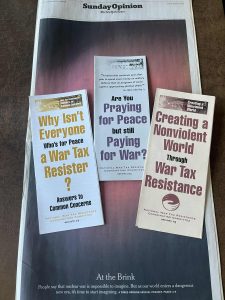Editors Note this piece was writen by Paul Popinchalk and first appeared in The Catholic Radical, January 2025 a publication of the Worcester Catholic Worker that will be helping host the NWTRCC November 7-9 Conference. Paul will be speaking on a panel on resistance along with Claire Schaeffer-Duffy a member of the Saints Francis & Thérèse Catholic Worker. If you have not yet registered for the NWTRCC Conference please do so today. The link to the schedule and registration can be found here.

I am a member of Massachusetts Peace Action and a lifelong pacifist. I’m also a husband, father, and grandfather who despairs about the global tensions that could result in nuclear war. I grew up in the small farming community of Preston, Connecticut and I’ve been following a series in The New York Times entitled “At the Brink.” The October 10th issue caught my eye because it discussed how America is preparing for its nuclear future by focusing on a fifth-grade classroom at Connecticut’s Preston Veterans Memorial School. In Melissa Durkee’s classroom, the children were engaged in a six-week course taught by a defense contractor from General Dynamics, the leading manufacturer of the US nuclear ballistic missile submarine fleet. When the contractor asks the children, “Does anyone know why we are here?” 10-year-old Adalie shoots her hand into the air and replies, “Because you’re building submarines and you need people and you’re teaching us about it in case we’re interested in working there when we get older?”

At the Brink New York Times series with NWTRCC pamphlets photo by Chrissy Kirchhoefer
Adalie is correct. The US Navy has put in an order for General Dynamics to produce 12 nuclear ballistic missile submarines by 2042, a job that’s projected to cost $130 billion. Thousands of workers will be required to fulfill this order. General Dynamics over the past 18 months has traveled to elementary schools across New England to teach children the basics of submarine manufacturing and perhaps inspire some students to consider one day joining the shipyard.
The US already fields a fleet of 12 ballistic missile submarines. Each of these submarines has 20 active missile tubes with each missile carrying 4 or 5 warheads. Every submarine possesses 2.5 times the explosive power of ALL the bombs dropped during World War II.
This is only part of the spending spree that currently drives our nation’s preparation for nuclear war. The Pentagon oversees the US nuclear triad. This is a three-sided military structure that consists of land-based, air-launched, and sea-based nuclear weapons systems. The Air Force manages 400 Minuteman intercontinental ballistic missiles, each with a single nuclear warhead. All of these missiles are scheduled for replacement. These missiles are located in silos 80 feet underground in the backyards and farm fields of midwesterners in Wyoming, Nebraska, Colorado, Montana, and North Dakota. The new missiles will be installed over 20 years at a cost of approximately $141 billion. For the past two years, representatives of the US Air Force have scoured the northern Great Plains to talk to residents about the plans for the new missiles and support buildings that will need to be constructed under this renewal program over the next 20 years.

National Priorities Project’s Program Director Lindsay Koshgarian, will be joining NWTRCC Friday November 7th 2025
Another key element of these weapon systems upgrades is the manufacturing of what the industry calls plutonium pits to create the cores that trigger the explosions of nuclear bombs. Congress has directed the Los Alamos National Lab in New Mexico to produce 30 plutonium pits a year by 2026 along with another 50 pits per year to be created at the Savannah River National Laboratory in South Carolina. When this mass production of these plutonium pits was undertaken at the Rocky Flats production site in Colorado, things did not go well. There were rampant environmental violations and huge security issues related to the risk of stolen material getting into the hands of bad actors. The price tag for this decades-long program is estimated to cost $2 trillion. The intellectual capability of tens of thousands of America’s finest scientists and manufacturing workers and all the trillions of dollars that these programs will cost over decades is to reinforce the perverse concept of MAD, Mutual Assured Destruction. It is the theory that nuclear-armed enemies of the United States will never attack us because they understand that our response will guarantee the annihilation of our opponents.

Photo by Chrissy Kirchhoefer
In 1963, Saint John XXIII, writing in his Encyclical Letter Pacem in Terris, urged the prohibition of atomic weapons and stated that authentic and lasting international peace cannot rest on a balance of military power but only mutual trust. He called for the breakdown of the climate of distrust that could dismantle international arms control frameworks and the growth of new military technology. His foresight has turned out to be sadly accurate.
Pope Francis, after his 2019 apostolic journey to the Atomic Bomb Hypocenter Monument in Nagasaki, Japan, said:
“…one of the deepest longings of the human heart for security, peace, and stability. The possession of nuclear and other weapons of mass destruction is not the answer to this desire; indeed, they seem always to thwart it…. In a world where millions of children and families live in inhumane conditions, the money that is squandered …through the manufacture, upgrade, maintenance, and sale of ever more destructive weapons, is an affront crying out to heaven.”
This waste of human and material resources is occurring at a time when the Department of Housing and Urban Development estimates that there are over 650,000 homeless people in the United States.
In September 2017, Most Reverend John Wester, Archbishop of
Santa Fe in Albuquerque, New Mexico, wrote a pastoral letter entitled Living in the Light of Christ’s Peace, following his trip to Japan where he visited Hiroshima and Nagasaki. In the letter, he wrote: “It was a somber, sobering experience as I realized that on August 6, 1945, humanity crossed the line into the darkness of the nuclear age. Historically, the Archdiocese of Santa Fe has been part of a peace initiative, one that would help make sure these weapons would never be used again. I believe it is time to rejuvenate that peace work.”

Graphic from National Priorities Project who will be joining NWTRCC Friday November 7th
And so it is that we are called to raise up our voices and oppose this war funding and ask instead that we dedicate our treasure to immediate and sincere negotiation and dialogue to reduce the threat of nuclear war and lessen the suffering of humanity. We are blessed beyond measure that Worcester’s member of Congress, Representative Jim McGovern, along with Representative Earl Blumenauer of Oregon, have introduced House Resolution 77, a critical legislative organizing vehicle to elevate congressional debate and leadership on nuclear disarmament at this moment when the risk of nuclear war is greater than it’s been in over 60 years. This resolution called on the US to embrace the goals and provisions of the Treaty on the Prohibition of Nuclear Weapons and to take concrete steps to prevent nuclear war. Let us take to the streets and educate our fellow citizens about this critical call for action.
Paul first learned about nuclear dangers while working in the industry in Washington state and witnessing contaimination of the lands. He has since worked on environmental issues with groups including 350 Central MASS, Center for Nonviolent Solutions and Massachusetts Peace Action.
Read the introduction to The New York Times’ “At the Brink” series.
